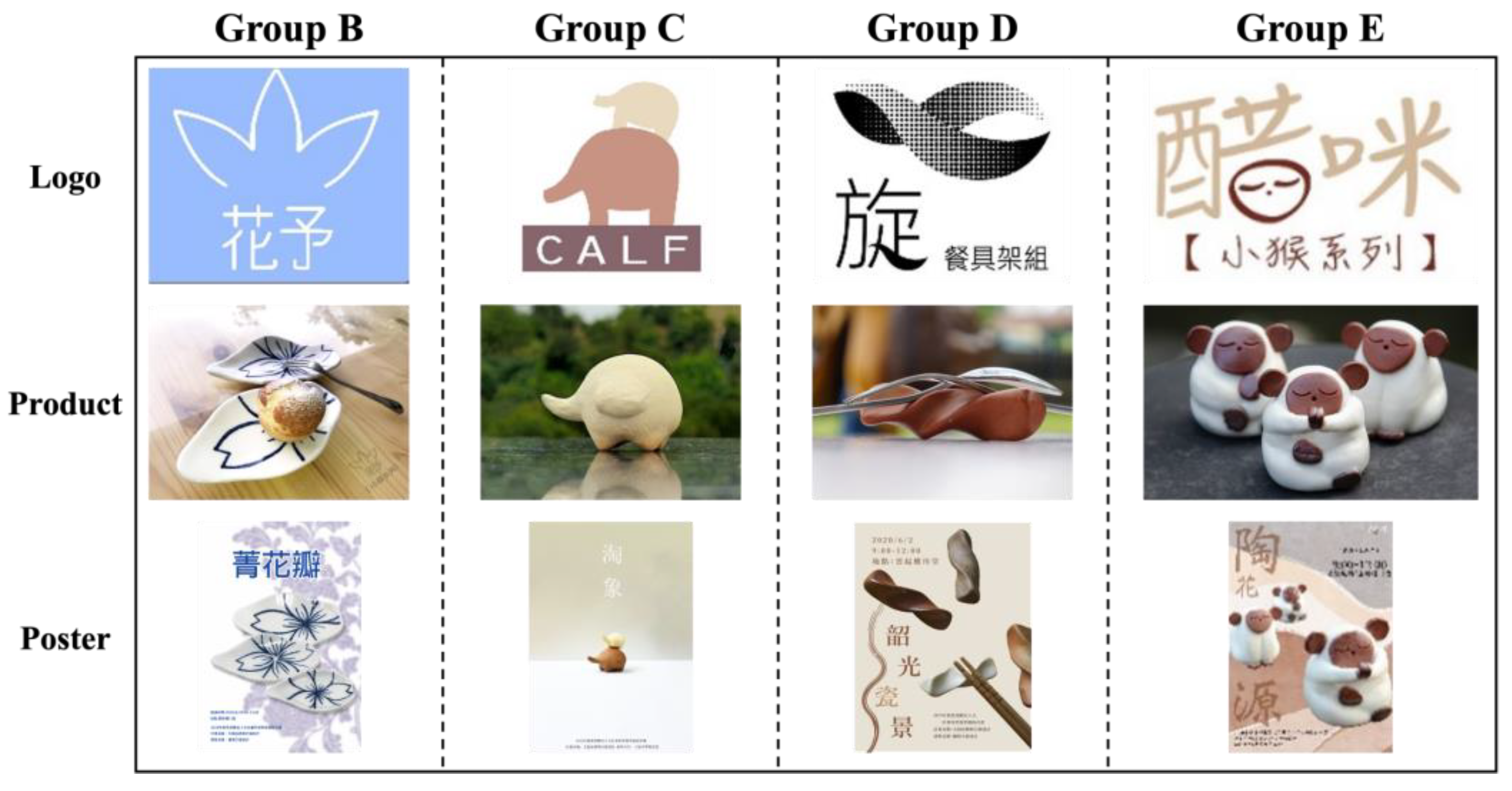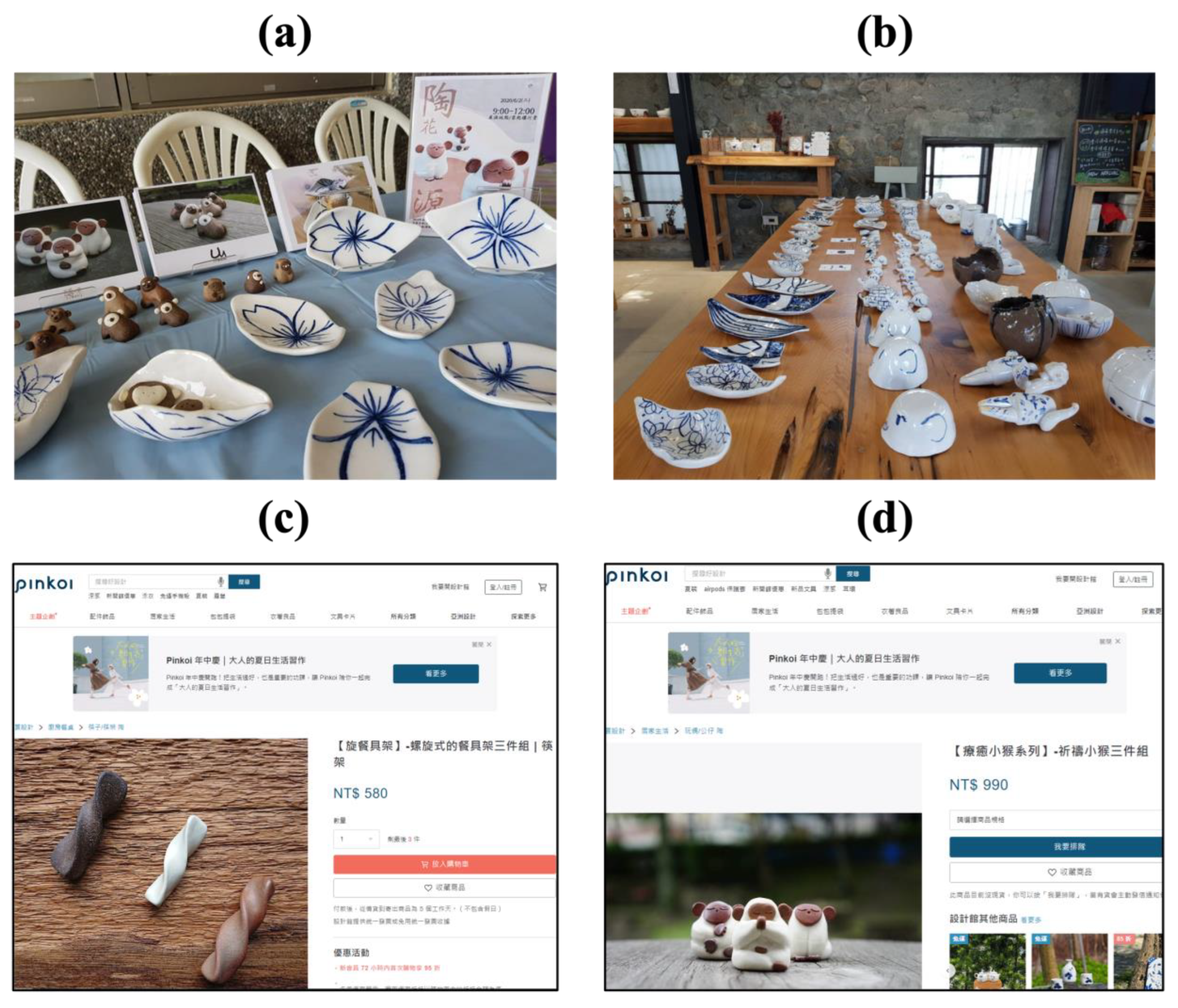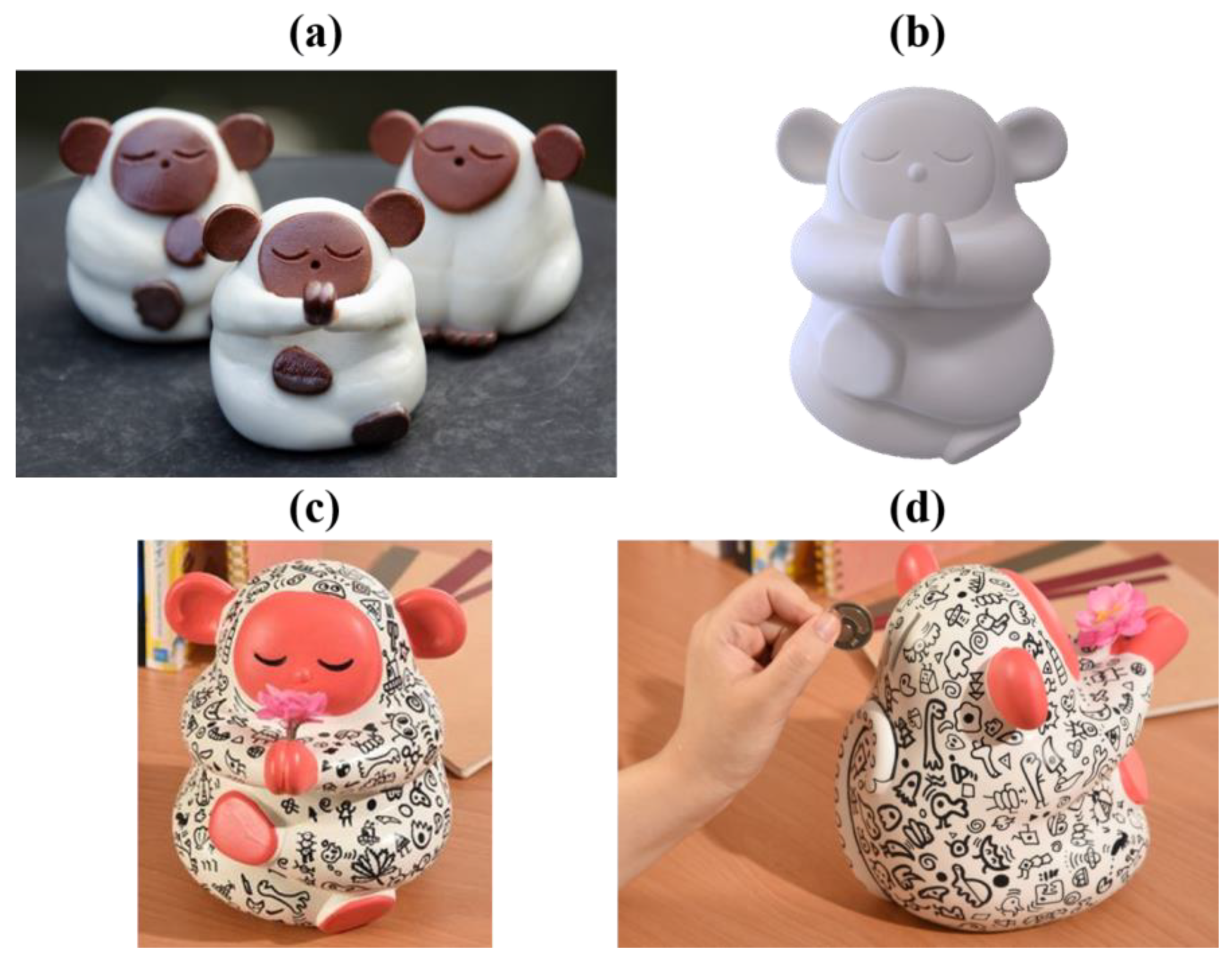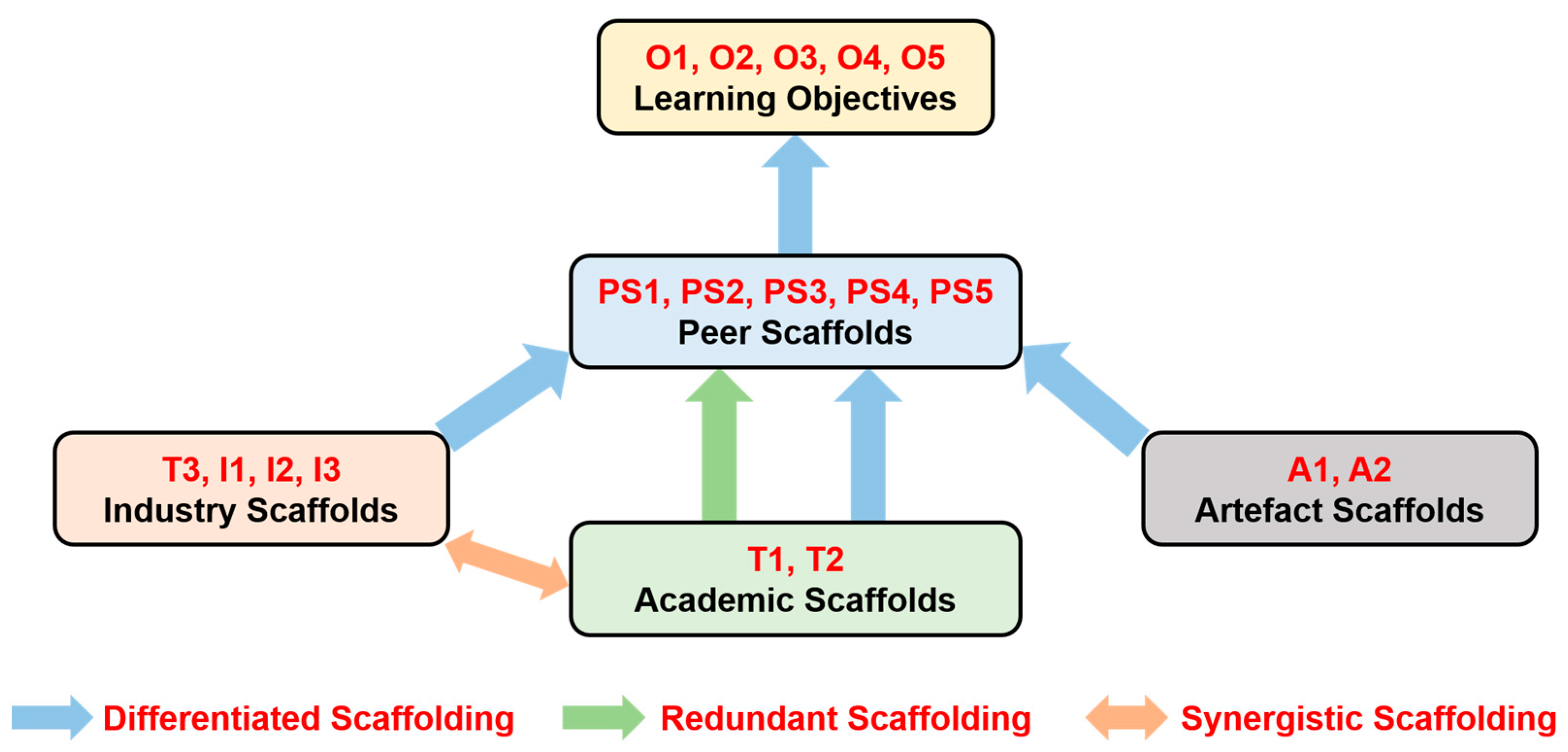Exploring an Interdisciplinary Curriculum in Product and Media Design Education: Knowledge Innovation and Competency Development
Abstract
:1. Introduction
1.1. Research Background and Motivation
1.2. Research Objectives
- This study develops an optimized interdisciplinary learning pathway based on distributed scaffolding theory to foster knowledge innovation and competency enhancement for product and media design students. The research question explores how to optimize such pathway design leveraging scaffolding theory. The method implements distributed scaffolding by integrating faculty support systems, enabling effective knowledge flow and student capability cultivation, as evidenced by outstanding project outcomes. This optimized learning pathway will also enable the selection of outstanding student prototypes for mass production [17,18,19,20].
- This study implements a collaborative triple-helix model engaging a ceramics studio to integrate product design, media design, and e-marketing education. The research investigates the potential of this collaborative approach in enhancing interdisciplinary knowledge and honing practical skills for students. The method establishes synergetic university–industry–government interactions, allowing students to achieve innovative design and marketing accomplishments through active participation [21,22,23].
- This study examines the professional competencies and interdisciplinary knowledge required to equip product- and media design students for future complexities. The research focuses on developing a curriculum prototype tailored to cultivate transformative competencies using immersive teaching and learning techniques. The method applies distributed scaffolding strategies to provide customized support for capability building, engaging students in projects to expand critical faculties crucial for navigating uncertainties ahead, as outlined in the OECD Learning Compass 2030 report [1,15,24].
2. Literature Review
2.1. Knowledge Competency
- Disciplinary knowledge encompasses concepts and details within a specific subject, providing a foundation for intrinsic structure and underlying principles. It serves as a basis for further learning, facilitating the exploration of interdisciplinary connections and the practical application of knowledge in different contexts [7,25,26].
- Interdisciplinary knowledge focuses on understanding and solving complex problems by integrating concepts and content from multiple disciplines. It nurtures valuable competencies, including transferring key concepts, recognizing interconnectedness, thematic learning, creating new topics, and project-based learning [1,27,28].
- Epistemic knowledge involves understanding subject specialists’ and practitioners’ thinking and working processes. It encourages students to connect knowledge with real-world problems and fosters the development of “learning to learn” skills [29].
- Procedural knowledge entails understanding how to perform specific actions or steps to achieve a goal. This transferable knowledge is applicable in various contexts and is valuable in solving complex real-world problems. Design thinking approaches are often employed to apply procedural knowledge effectively [30,31,32,33,34].
2.2. Triple-Helix Model
2.3. Distributed Scaffolding Theory
3. Course Design Methodology
3.1. Course Description
- Group A, consisting of four members, was fully engaged during the first semester. However, due to the perceived complexity of their project, the group members decided not to continue into the second semester.
- Group B, comprising four members, participated completely in the first semester. Yet, due to the considerable distance from the school to the 3S4S workshop, three members chose not to enroll for the second semester.
- Groups C and D, with five and four members, respectively, completed both semesters of the course without interruption.
- Group E, with five members, did not participate in the first semester. Motivated by the influence of their peers and personal interests, they proactively developed and created their project ideas during the winter break. Their initiative received recognition and encouragement from the instructor, leading them to complete the winter workshop and the second semester actively.
3.2. Course Planning
- Design proposal. Each group presented four proposals related to the Mother’s Day theme, including story proposals, sketches, design plans, and mold prototypes. The proposals underwent multiple revisions based on teacher evaluations until approval was granted.
- Workshop practice. The approved proposals were brought to life in the ceramic studio, where the students participated in hands-on activities such as kneading, shaping, modifying forms, repairing, biscuit firing, glazing, painting, and final firing. Microproduction techniques were also explored.
- Digital design. Students used digital tools to complete tasks such as product photography, brand logo design, image animation, poster creation, and cool card design.
- Marketing test. The products were showcased to the public through a Christmas Creative Fair, accompanied by a questionnaire survey. The 3S4S manager evaluated and approved selected products for presentation on the Pinkoi Online Design Gallery website.
- Marketing. Limited product production and patents were obtained to protect intellectual property. The patent aimed to license the aesthetic value of the “Funny Monkey” artwork, offering an experiential understanding of its economic value.
3.3. Course Practice
3.3.1. Design Proposal Stage
- Group A designed the Health Tableware, incorporating various sports and wellness designs to promote the idea that expectant mothers want healthy bodies. This included condiment jars and tableware inspired by yoga and hanging kanas.
- Group B created the Flower Tea Plate, a celadon tableware with a simple hand-painted pattern of flower petals, symbolizing Mother’s Day. The finished product could be used to serve cakes and desserts or as a display of small accessories such as earrings and rings.
- Group C designed the Little Elephant Chopstick Holder, representing the special bond between mother and child. The design reflects the close relationship between parents and children, with the elephant symbolizing this extraordinary connection.
- Group D developed the Spinning Tableware Holder, a delicate spiral cutlery holder that securely holds cutlery, representing the mother’s love for her child.
- Group E designed the Funny Monkey, a figure with big ears that symbolizes listening to everything in the world. The different gestures of the figure, including folded hands, kneeling down, and both hands in prayer, represent blessings, giving, care, and love, similar to a mother’s unconditional love for her child.
3.3.2. Workshop Practice Stage
- Group A completed the firing process for their first batch of work. However, a disagreement during the sketch proposal stage resulted in a loss of interest among group members, leading them to not continue with the course in the following term.
- Groups B and E followed the curriculum, gradually advancing from clay kneading to kiln production.
- Groups C and D encountered two challenges in their initial work. First, they faced difficulties in mastering the shape kneading. Second, they needed help with the quality of the glaze lines. Despite repeated practice, the workshop teachers did not approve of their work. As a result, they went back to the first stage and created new proposals. Group C, in particular, shifted its focus from designing an ornament storage box to a chopstick holder group. Likewise, Group D transitioned from designing a complete tableware set for afternoon tea to a tableware stand. These refinements allowed both groups to develop transformative competencies, such as reconciling tensions and dilemmas [7,15] and taking responsibility [14] for their work.
3.3.3. Digital Design Stage
3.3.4. Marketing Test Stage
3.3.5. Marketing Stage
3.4. Course Scaffolding Framework
4. Results and Discussion
4.1. Questionnaire Analysis
4.2. Transformative Competencies Development by Distributed Scaffolding
- Teacher scaffolding (T1, T2, and T3) was crucial in supporting students and ensuring progress [8]. Successful outcomes were facilitated through collaboration between teachers and students, while conflicts within groups and a reluctance to accept teacher guidance hindered progress. As shown in Figure 1, Group B showed a positive impact of teacher support. The only student in the group who continued participating in the second semester of the course successfully achieved the goal with the teacher’s help. In contrast, Group A faced difficulties due to conflicting ideas and a reluctance to accept teacher co-ordination. Team cohesion and social skills were essential in design projects [7,11].
- Students rely heavily on artefact scaffolding tools (A1 and A2) to complete tasks and achieve learning objectives (O1 to O5).
- The flexible support mechanism of distributed scaffolding significantly contributed to the creative process and the development of transformative competencies such as reconciling tensions and taking responsibility [14,15]. Peer suggestions, teacher responses, and collaboration were integral to the success of distributed scaffolding.
- With prior knowledge and experience in ceramic workshops, Group E exhibited a higher level of detail and integrity in their work to successfully drive them from the marketing test stage to the marketing stage (as shown in Figure 1). They served as a supportive and inspiring role model for other groups.
- During the marketing stage, the teacher scaffolding expanded to include patent offices (I1), distributors (I2), and mold developers (I3), providing invaluable support for the successful sales of Group E’s work on the Pinkoi e-commerce platform.
5. Conclusions
5.1. Optimised Learning Pathway for Interdisciplinary Curriculum
- This study successfully explores an optimized learning pathway for interdisciplinary knowledge innovation in designing professional practice courses (OECD, 2019). It implements distributed scaffolding theory [17,18,20,42] to enrich the pedagogy of product and media design courses. The curriculum design framework integrates interdisciplinary faculty support systems for product design, media design, and e-commerce marketing in collaboration with a ceramic workshop involved in regional development.
- The curriculum design framework effectively establishes knowledge innovation derived from the triple helix structure of university–industry–government [23,35]. The students in the course achieve significant results, including innovative ceramic designs, digital media marketing, branding, and online store operations, indicating their acquisition of interdisciplinary knowledge and transformative competencies.
- Scaffolding theory provides a robust support structure for students, as illustrated in Figure 1. Teacher support, peer collaboration, and the synergy between hardware and software are essential. Teacher reflections and strategies for addressing student challenges contribute to improving students’ learning paths, as shown in Groups C and D in Figure 1.
5.2. Transformative Competencies Development
- The curriculum focuses on building foundational disciplinary knowledge in product and media design. These initial stages give students the technical details and basic knowledge of their respective fields. They serve as a solid foundation for further exploration of interdisciplinary knowledge [1].
- The subsequent stages of the curriculum, the marketing test, and the marketing stages encompass epistemic, procedural, and interdisciplinary knowledge. These stages aim to develop students’ critical thinking, strategic action, and problem-solving abilities [12]. Through engagement in the entrepreneurial process, some participating students completed real-world projects, obtained patents, and received recognition in creative competitions, showcasing the effectiveness of interdisciplinary collaboration [10,23,35].
- Implementing distributed scaffolding theory provides a practical roadmap for designing interdisciplinary curricula. Peer scaffolds, teacher scaffolds, and artefact scaffolds form a cohesive support system that guides students’ learning pathways. Teacher companionship is identified as a crucial element in successful student scaffolding. The results highlight students’ enhanced learning abilities, creativity, interpretation, and professional competencies through participation in design projects [7,9,11,12].
- This research emphasizes the importance of transformative competencies in preparing students for an ever-changing world. By providing tangible evidence and a transferable pedagogical prototype, this study contributes to interdisciplinary education. It supports the development of individuals equipped with the skills needed to thrive in the future [14,15,33].
Author Contributions
Funding
Institutional Review Board Statement
Informed Consent Statement
Data Availability Statement
Acknowledgments
Conflicts of Interest
References
- OECD Future of Education and Skills 2030: OECD Learning Compass 2030; OECD Publishing: Paris, France, 2019. Available online: https://www.oecd.org/education/2030-project/contact/OECD_Learning_Compass_2030_Concept_Note_Series.pdf (accessed on 3 August 2022).
- Li, W.T.; Ho, M.C.; Yang, C. Design Thinking-Based Study of the Prospect of the Sustainable Development of Traditional Handicrafts. Sustainability 2019, 11, 4823. [Google Scholar] [CrossRef]
- Sawyer, R.K. Teaching creativity in art and design studio classes: A systematic literature review. Educ. Res. Rev. 2017, 22, 99–113. [Google Scholar] [CrossRef]
- Machado, R.H.; Conceição, S.V.; Pelissari, R.; Amor, S.B.; Resende, T.L. A multiple criteria framework to assess learning methodologies. Think. Ski. Creat. 2023, 48, 101290. [Google Scholar] [CrossRef]
- Norman, D. Why Design Education Must Change; Core77: New York, NY, USA, 2010; Available online: https://www.core77.com/posts/17993/why-design-education-must-change-17993 (accessed on 27 May 2023).
- Meyer, M.W.; Norman, D. Changing Design Education for the 21st Century. She Ji J. Des. Econ. Innov. 2020, 6, 13–49. [Google Scholar] [CrossRef]
- Hsiao, W.T.; Wu, M.C.; Lee, C.F.; Chang, W.L. An Analytic Study on Constructional Relationship of Intrapersonal Factors Fostering Innovation Competency: From Taiwanese Students’ Perspectives. EURASIA J. Math. Sci. Technol. Educ. 2019, 15, em1780. [Google Scholar]
- Tu, J.C.; Zhang, X.; Zhang, X.Y. Basic Courses of Design Major Based on the ADDIE Model: Shed Light on Response to Social Trends and Needs. Sustainability 2021, 13, 4414. [Google Scholar] [CrossRef]
- Sun, Y.; Lin, P.H.; Lin, R. From Data to Wisdom: A Case Study of OPOP Model. Educ. Sci. 2021, 11, 606. [Google Scholar] [CrossRef]
- Tung, F.W. An Entrepreneurial Process to Build a Sustainable Business for Indigenous Craft Revitalization. Des. J. 2021, 24, 363–383. [Google Scholar] [CrossRef]
- Zhang, X.Y.; Zhu, X.G.; Tu, J.C.; Yi, M. Measurements of Intercultural Teamwork Competence and Its Impact on Design Students’ Competitive Advantages. Sustainability 2022, 14, 175. [Google Scholar] [CrossRef]
- Cheng, Y.H.; Wang, T.J. The Relation of Influence between Leadership Style and Team Creativity of Integrated Design Companies. Des. J. 2017, 20, s2803–s2812. [Google Scholar]
- Grayling, A. “Creating New Value” Section of Future and Education and Skills 2030: Reflections on Transformative Competencies 2030; OECD Publishing: Paris, France, 2017. [Google Scholar]
- Steinberg, L. “Taking Responsibility” as a Transformative Competency in the OECD 2030 Learning Framework” Section of Future and Education and Skills 2030: Reflections on Transformative Competencies 2030; OECD Publishing: Paris, France, 2017. [Google Scholar]
- 15. In What Students Learn Matters: Towards a 21st Century Curriculum; OECD Publishing: Paris, France, 2020. [CrossRef]
- Helin, J. How to Define and Implement Competencies for SDG Target 4.7; Bridge47: Brussels, Belgium, 2017. [Google Scholar] [CrossRef]
- Tabak, I. Synergy: A Complement to Emerging Patterns of Distributed Scaffolding. J. Learn. Sci. 2004, 13, 305–335. [Google Scholar] [CrossRef]
- Puntambekar, S.; Kolodner, J.L. Toward Implementing Distributed Scaffolding: Helping Students Learn Science from Design. J. Res. Sci. Teach. 2005, 42, 185–217. [Google Scholar] [CrossRef]
- Reiser, B.J.; Tabak, I. Scaffolding. In The Cambridge Handbook of the Learning Sciences, 2nd ed.; Sawyer, R.K., Ed.; Cambridge University Press: New York, NY, USA, 2014; pp. 44–62. [Google Scholar]
- Puntambekar, S. Distributed Scafolding: Scafolding Students in Classroom Environments. Educ. Psychol. Rev. 2022, 34, 451–472. [Google Scholar] [CrossRef]
- Leydesdorff, L. The Knowledge-Based Economy and the Triple Helix Model. Annu. Rev. Inf. Sci. Technol. 2010, 44, 367–417. [Google Scholar] [CrossRef]
- Lawton Smith, H.; Leydesdorff, L. The Triple Helix in the Context of Global Change: Dynamics and Challenges. Prometheus 2014, 32, 321–336. [Google Scholar] [CrossRef]
- Leydesdorff, L. Evolutionary and Institutional Triple Helix Models. In The Evolutionary Dynamics of Discursive Knowledge. Qualitative and Quantitative Analysis of Scientific and Scholarly Communication; Springer: Cham, Switzerland, 2021; pp. 89–113. [Google Scholar]
- Education 2030: The Future of Education and Skills; Position Paper. OECD Publishing: Paris, France, 2018. Available online: http://www.oecd.org/education/2030/E2030%20Position%20Paper%20(05.04.2018).pdf (accessed on 3 August 2022).
- Voogt, J.; Nieveen, N.; Klopping, S. Curriculum Overload: A Literature Study; Report Prepared under the Auspices of the OECD Future of Education and Skills 2030 Project; University of Amsterdam: Amsterdam, The Netherlands, 2017. [Google Scholar]
- Gardner, H. Five Minds for the Future; Harvard Business School Press: Cambridge, MA, USA, 2006. [Google Scholar]
- Harlen, W. Principles and Big Ideas of Science Education; Association of Science Education: Hatfield, UK, 2010. [Google Scholar]
- Erickson, H.; Lanning, L.; French, R. Concept-Based Curriculum and Instruction for the Thinking Classroom, 2nd ed.; Corwin: Thousand Oaks, CA, USA, 2017. [Google Scholar]
- Young, M.; Muller, J. Curriculum and the Specialization of Knowledge, 1st ed.; Routledge: London, UK, 2015. [Google Scholar]
- Byrnes, J.P.; Wasik, B.A. Role of Conceptual Knowledge in Mathematical Procedural Learning. Dev. Psychol. 1991, 27, 777–786. [Google Scholar] [CrossRef]
- Benander, R. A Literature Summary for Research on the Transfer of Learning; OECD Publishing: Paris, France, 2018; Available online: http://www.oecd.org/education/2030-project/about/documents (accessed on 3 August 2022).
- Pourdehnad, J.; Wexler, E.; Wilson, D. System and Design Thinking: A Conceptual Framework for Their Integration. Organisational Dynamics Working Papers. 2011, Volume 10, pp. 10–16. Available online: https://repository.upenn.edu/od_working_papers/10/ (accessed on 3 December 2022).
- Goldman, S. Design Thinking. In The SAGE Encyclopedia of out of School Learning; Kylie, P., Ed.; Sage Publishing: Thousand Oaks, CA, USA, 2017; pp. 210–212. [Google Scholar]
- Mobus, G. Teaching Systems Thinking to General Education Students. Ecol. Model. 2018, 373, 13–21. [Google Scholar] [CrossRef]
- Etzkowitz, H.; Leydesdorff, L. The dynamics of innovation: From National Systems and “Mode 2” to a Triple Helix of university–industry–government relations. Res. Policy 2020, 29, 109–123. [Google Scholar] [CrossRef]
- Wood, D.; Bruner, J.S.; Ross, G. The Role of Tutoring in Problem Solving. J. Child Psychol. Psychiatry 1976, 17, 89–100. [Google Scholar] [CrossRef]
- Vygotsky, L.S. Mind in Society: The Development of Higher Psychological Processes; Harvard University Press: Cambridge, MA, USA, 1978. [Google Scholar]
- Cole, M. The Zone of Proximal Development: Where Culture and Cognition Create Each Other. In Culture, Communication, and Cognition: Vygotskian Perspectives; Wertsch, J.V., Ed.; Cambridge University Press: New York, NY, USA, 1985. [Google Scholar]
- Moll, L.C. Introduction. In Vygotsky and Education: Instructional Implications and Applications of Sociohistorical Psychology; Moll, C.L., Ed.; Cambridge University Press: Cambridge, UK, 1990. [Google Scholar]
- Syamsuddin, A.; Babo, R.; Sulfasyah, S.; Rahman, S. Mathematics Learning Interest of Students Based on the Difference in the Implementation of Model of Thematic Learning and Character-Integrated Thematic Learning. Eur. J. Educ. Res. 2021, 10, 581–591. [Google Scholar] [CrossRef]
- Guo, P.; Saab, N.; Post, L.S.; Admiraal, W. A review of project-based learning in higher education: Student outcomes and measures. Int. J. Educ. Res. 2020, 102, 101586. [Google Scholar] [CrossRef]
- Fretz, E.B.; Wu, H.K.; Zhang, B.; Davis, E.A.; Krajcik, J.S.; Soloway, E. An Investigation of Software Scaffolds Supporting Modeling Practices. Res. Sci. Educ. 2002, 32, 567–589. [Google Scholar] [CrossRef]





| Aspect 1: Actual Feelings about the Course | |||
|---|---|---|---|
| Question | Semester | Mean | Standard Deviation |
| 1-1 Clear emphasis on course description | 1 | 3.786 | 0.802 |
| 2 | 4.625 | 0.500 | |
| 1-2 Sequential and progressive course planning | 1 | 3.929 | 0.730 |
| 2 | 4.688 | 0.479 | |
| 1-3 Course content aligned with objectives | 1 | 4.000 | 0.784 |
| 2 | 4.625 | 0.500 | |
| 1-4 Interdisciplinary knowledge transmission | 1 | 3.929 | 0.829 |
| 2 | 4.688 | 0.479 | |
| 1-5 Appropriate use of on-line platforms for enhanced teacher-student interaction | 1 | 3.929 | 0.917 |
| 2 | 4.500 | 0.816 | |
| 1-6 Industry-academia collaboration | 1 | 4.286 | 0.726 |
| 2 | 4.938 | 0.250 | |
| Aspect 2: Improvement in Abilities and Knowledge | |||
| 2-1 Application of digital tools for data processing and analysis | 1 | 3.929 | 0.997 |
| 2 | 4.563 | 0.727 | |
| 2-2 Enhancement of collaboration with individuals of different professional backgrounds | 1 | 4.286 | 0.726 |
| 2 | 4.750 | 0.577 | |
| 2-3 Improvement in interdisciplinary learning and application | 1 | 4.286 | 0.726 |
| 2 | 4.688 | 0.602 | |
| 2-4 Increase in interest in proactive exploration in the field of digital humanities | 1 | 4.000 | 0.877 |
| 2 | 4.625 | 0.619 | |
| 2-5 Enhancement of abilities in applying digital humanities to practical contexts | 1 | 3.929 | 0.829 |
| 2 | 4.813 | 0.403 | |
| 2-6 Increase in confidence for future employment | 1 | 4.143 | 0.949 |
| 2 | 4.375 | 0.885 | |
| 2-7 Willingness to recommend the course to other students | 1 | 4.071 | 0.730 |
| 2 | 4.500 | 0.816 | |
| 2-8 Will to take advanced courses | 1 | 4.071 | 0.730 |
| 2 | 4.500 | 0.816 | |
| Aspect 3: Satisfaction with Course Expectations | |||
| 3-1 The course has met the course expectations compared to before enrollment | 1 | 3.929 | 0.730 |
| 2 | 4.625 | 0.500 | |
Disclaimer/Publisher’s Note: The statements, opinions and data contained in all publications are solely those of the individual author(s) and contributor(s) and not of MDPI and/or the editor(s). MDPI and/or the editor(s) disclaim responsibility for any injury to people or property resulting from any ideas, methods, instructions or products referred to in the content. |
© 2023 by the authors. Licensee MDPI, Basel, Switzerland. This article is an open access article distributed under the terms and conditions of the Creative Commons Attribution (CC BY) license (https://creativecommons.org/licenses/by/4.0/).
Share and Cite
Kao, Y.-F.; Chen, H.-C.; Lo, J.-H. Exploring an Interdisciplinary Curriculum in Product and Media Design Education: Knowledge Innovation and Competency Development. Sustainability 2023, 15, 16369. https://doi.org/10.3390/su152316369
Kao Y-F, Chen H-C, Lo J-H. Exploring an Interdisciplinary Curriculum in Product and Media Design Education: Knowledge Innovation and Competency Development. Sustainability. 2023; 15(23):16369. https://doi.org/10.3390/su152316369
Chicago/Turabian StyleKao, Yi-Fang, Hung-Cheng Chen, and Jung-Hua Lo. 2023. "Exploring an Interdisciplinary Curriculum in Product and Media Design Education: Knowledge Innovation and Competency Development" Sustainability 15, no. 23: 16369. https://doi.org/10.3390/su152316369
APA StyleKao, Y.-F., Chen, H.-C., & Lo, J.-H. (2023). Exploring an Interdisciplinary Curriculum in Product and Media Design Education: Knowledge Innovation and Competency Development. Sustainability, 15(23), 16369. https://doi.org/10.3390/su152316369






